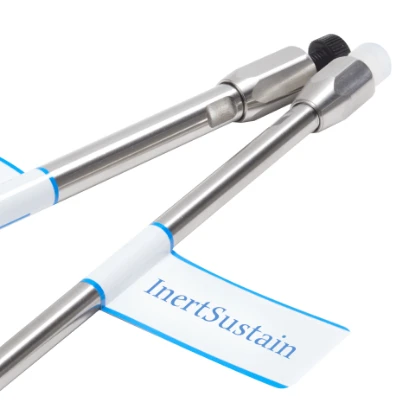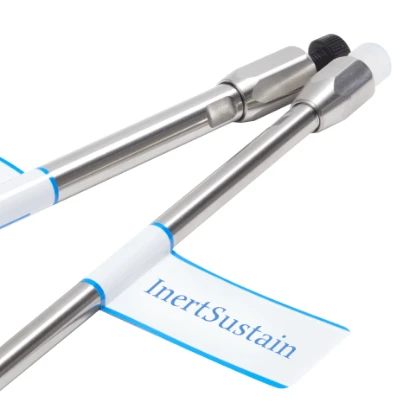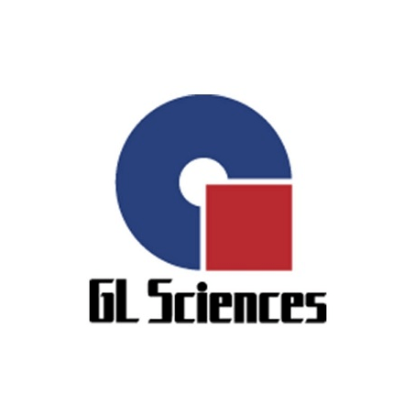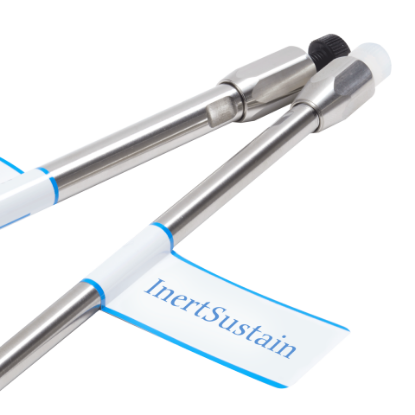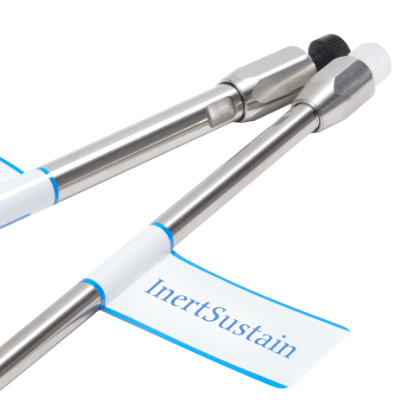Reversed Phase HPLC Columns
Experience a wide selection of phases for reversed phase HPLC with GL Sciences reversed phase columns. Select from phases including C18, C8, C4, phenyl and cyano functionalized groups for distinct analyte selectivity. GL Sciences reversed phase columns are available in many sizes and formats featuring our high-purity silica and end-capping. Read more
- 1
- 2
| Column | Features | USP Code | Particle Size (µm) | Pore Size (nm) | Surface Area (m2/g) | Carbon Loading | End-Capping | Inertness | Recommended pH range |
| InertSustain C18 | First choice with ultra high inertness and high durability | L1 | 2, 3, 5, 10 | 10 | 350 | 14 | Yes | ★★★★★ | 1 - 10 |
| InertSustain AQ-C18 | First choice for high polar compounds | L1, L96 | 1.9, 3, 5 | 10 | 350 | 13 | Yes | ★★★★★ | 1 - 10 |
| InertSustainSwift C18 | First analysis with ultra high inertness and high durability | L1 | 1.9, 3, 5 | 20 | 200 | 9 | Yes | ★★★★★ | 1 - 10 |
| InertSustain AX-C18 | Analysis of anionic highly polar compounds | L1, L78 | 3, 5 | 20 | 200 | 8 | Yes | ★★★★ | 1 - 9 |
| InertCore Plus C18 | Ideal for analyses requiring a high number of theoretical stages | L1 | 2.6 | 9 | 200 | 15 | Yes | ★★★★ | 1 - 10 |
| Inertsil ODS-HL | Ultra high retentivity, High-density bonding of C18 phase | L1 | 3, 5 | 10 | 450 | 23 | Yes | ★★★★★ | 2 - 7.5 |
| Inertsil ODS-4 | Ultra high inertness, High plate count, Medium retentivity | L1 | 2, 3, 5 | 10 | 450 | 11 | Yes | ★★★★★ | 2 - 7.5 |
| Inertsil ODS-4V | Inertsil ODS-4 Validated column | L1 | 3, 5 | 10 | 450 | 11 | Yes | ★★★★★ | 2 - 7.5 |
| Inertsil ODS-3 | Strong retentivity, Lower column backpressure, Very inert | L1 | 2, 3, 4, 5, 10 | 10 | 450 | 15 | Yes | ★★★★ | 2 - 7.5 |
| Inertsil ODS-3V | Inertsil ODS-3 Validated column | L1 | 3, 5 | 10 | 450 | 15 | Yes | ★★★★ | 2 - 7.5 |
| Inertsil ODS-SP | Weak retentivity, for hydrophobic compounds | L1 | 3, 5 | 10 | 450 | 8.5 | Yes | ★★★★ | 2 - 7.5 |
| Inertsil ODS-P | High steric selectivity | L1 | 3, 5 | 10 | 450 | 29 | None | ★★★ | 2 - 7.5 |
| Inertsil ODS-EP | A polar functional group embedded | L1 | 5 | 10 | 450 | 9 | None | ★★★★ | 2 - 7.5 |
| Inertsil WP300 C18 | Analysis of high molecules | L1 | 5 | 30 | 150 | 9 | Yes | ★★★★ | 2 - 7.5 |
| Inertsil ODS-2 | Ultra pure silica gel is used | L1 | 5 | 15 | 320 | 18.5 | Yes | ★★★★ | 2 - 7.5 |
| Inertsil ODS | Inertness 1st generation | L1 | 5,10 | 10 | 350 | 14 | Yes | ★★ | 2 - 7.5 |
| InertSustain C8 | First choice with ultra high inertness and high durability | L7 | 2, 3, 5 | 10 | 350 | 8 | Yes | ★★★★★ | 1 - 10 |
| InertSustainSwift C8 | High inertness and high durability C8 column | L7 | 1.9, 3, 5 | 20 | 200 | 6 | Yes | ★★★★★ | 1 - 10 |
| Inertsil C8-4 | Ultra high inertness, High plate count, Low retentivity | L7 | 2, 3, 5 | 10 | 450 | 5 | Yes | ★★★★★ | 2 - 7.5 |
| Inertsil C8-3 | Strong retentivity, Lower column backpressure, Very inert | L7 | 2, 3, 5, 10 | 10 | 450 | 9 | Yes | ★★★★ | 2 - 7.5 |
| Inertsil C8 | Ultra pure silica gel is used | L7 | 5 | 15 | 320 | 10.5 | Yes | ★★ | 2 - 7.5 |
| Inertsil C4 | Low retentivity | L26 | 5 | 15 | 320 | 7.5 | Yes | ★★★★ | 2 - 7.5 |
| Inertsil WP300 C8 | Suitable for high molecules | L7 | 5 | 30 | 150 | 4 | Yes | ★★★★ | 2 - 7.5 |
| Inertsil WP300 C4 | L26 | 5 | 30 | 150 | 3 | ★★★★ | 2 - 7.5 | ||
| InertSustain PFP | Extremely Strong retention of highly polar basic compounds. | L43 | 3, 5 | 10 | 350 | 10 | Yes | ★★★★★ | 2 - 7.5 |
| InertSustain Phenylhexyl | Strong π-π interactions and hydrophobic interactions | L11 | 3, 5 | 10 | 350 | 9 | Yes | ★★★★★ | 1 - 10 |
| InertSustain Pheny | Extremely strong π-π interactions | L11 | 2, 3, 5 | 10 | 350 | 10 | ★★★★ | 2 - 7.5 | |
| Inertsil Ph-3 | Strong π-π interactions | L11 | 2, 3, 5 | 10 | 450 | 9.5 | ★★★ | 2 - 7.5 | |
| Inertsil Ph | High inertness, Weak π-π interactions | L11 | 5 | 15 | 320 | 10 | Yes | ★★★ | 2 - 7.5 |
| InertSustain Cyano | Ultra inertness and can be used in reversed phase mode | L10 | 3, 5 | 10 | 350 | 8 | Yes | ★★★★ | 2 - 7.5 |
Comparison of Phases
The figure below shows the strength of the stereoselectivity and the pi-interaction with respect to the holding strength of the reversed-phase column. The retention strength, stereoselection system, and strength of pi-interaction are based on the retention coefficient of amylbenzene, retention ratio of o-terphenyl and triphenylene, and retention ratio of amylbenzene and triphenylene, respectively. These are plotted below. In addition, the polar group-encapsulating (embed) type column provides a large effect on other interactions; thus, it was plotted in the type in order to distinguish it from the other columns.
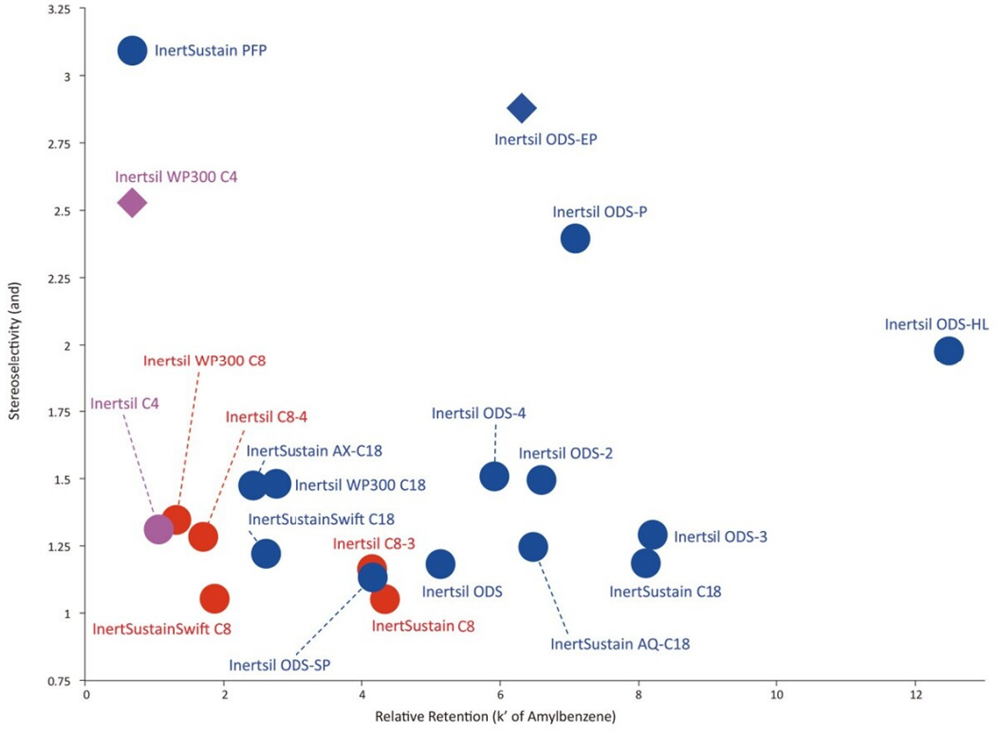
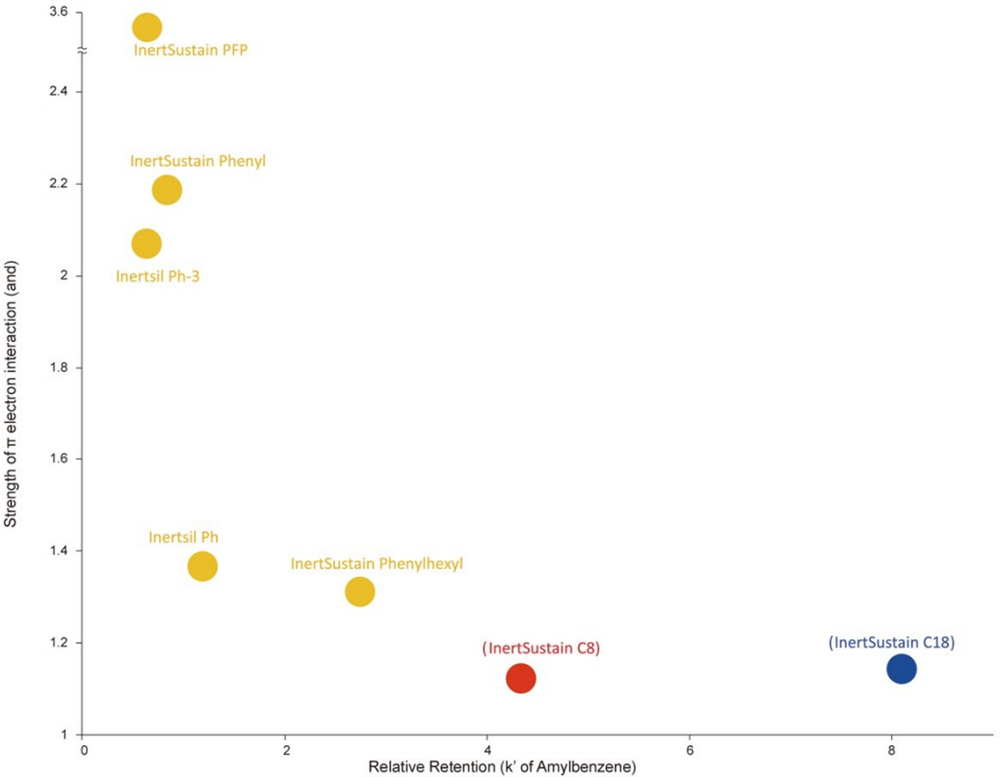
Selectivity Comparison of Reversed Phase Columns with Sample analytes
Selectivity of reversed-phase columns are compared under the same conditions, packing material size and column size. Chemical structural formulas used for the comparison are shown at right. Separation differences between basic compounds, acidic compounds, alkyl benzenes and polyaromatic compounds shows the differences of column selectivity. The more silanol groups on the packing material lead the later elution time of caffeine compared with that of phenol. The higher hydrophobicity of the column shows the later elution time of n-Amylbenzene compared with that of n-Butylbenzene. The higher steric selectivity of the column shows the later elution time of Triphenylene compared with that of o-Terphenyl.
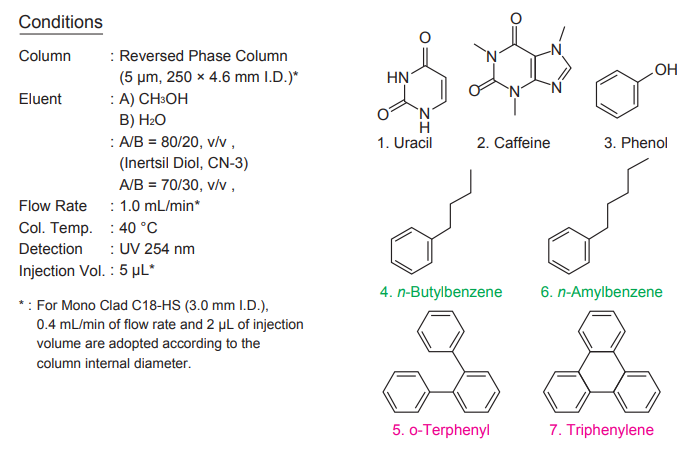

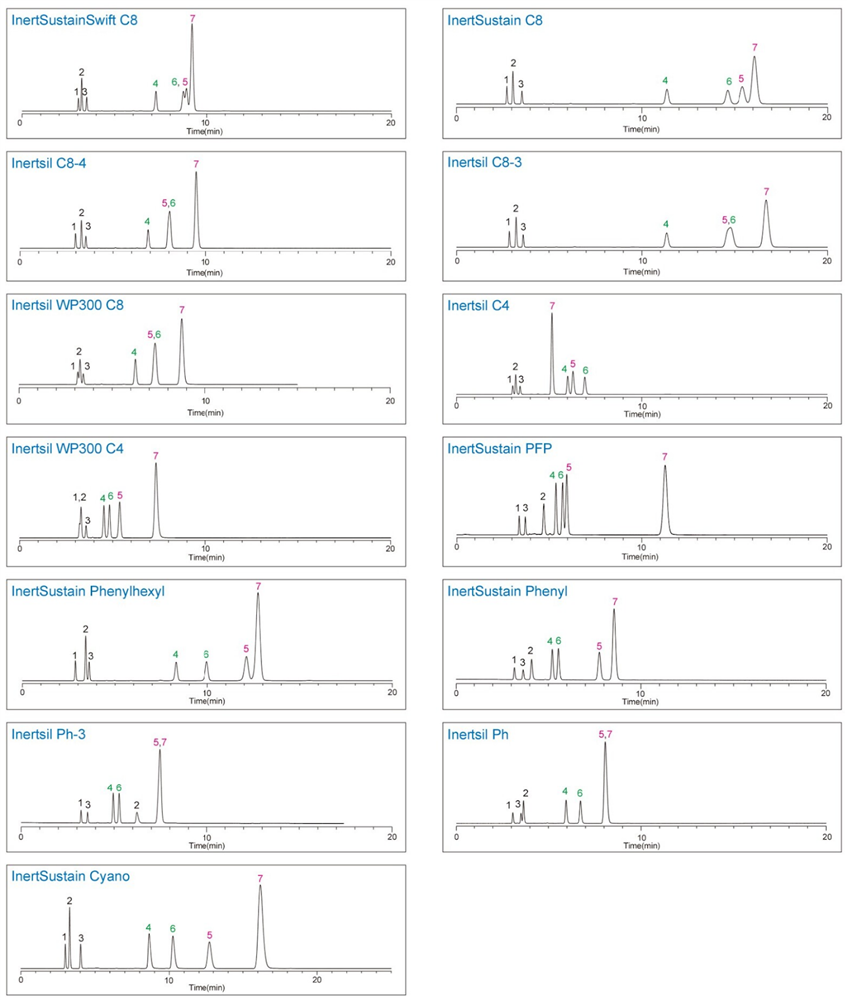
Reversed Phase Column Selection
For Molecular Weight <5,000
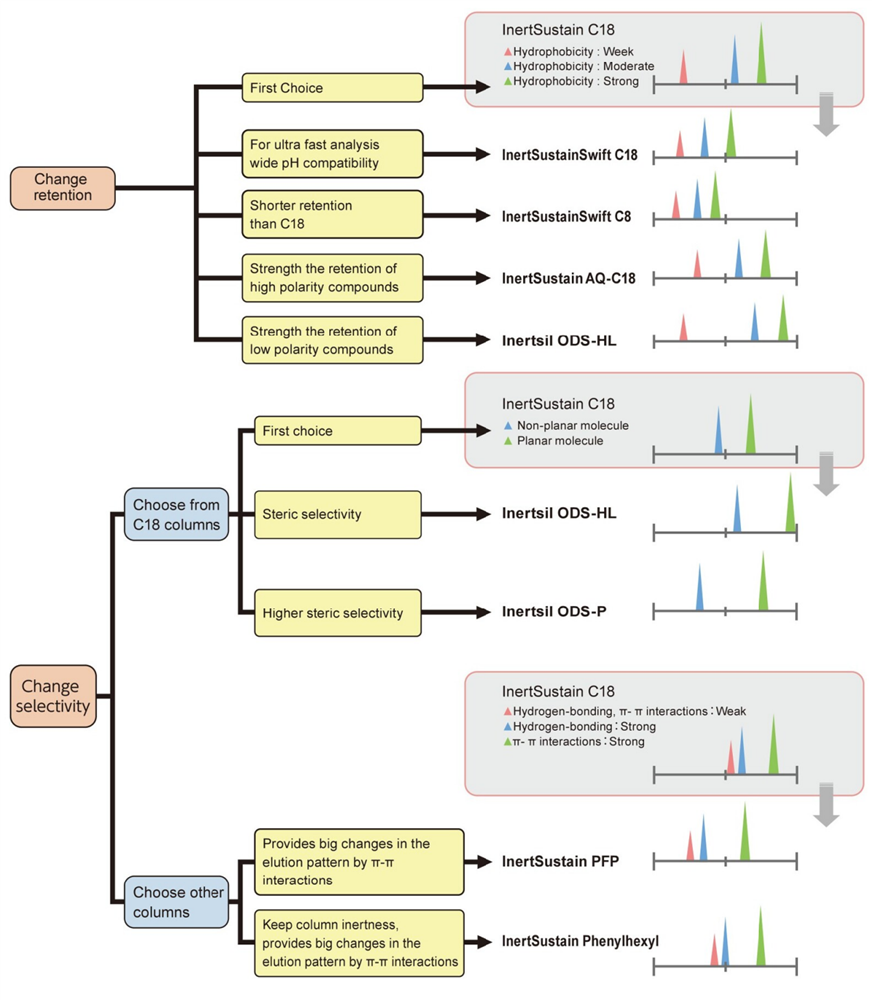
For Molecular Weight >5,000
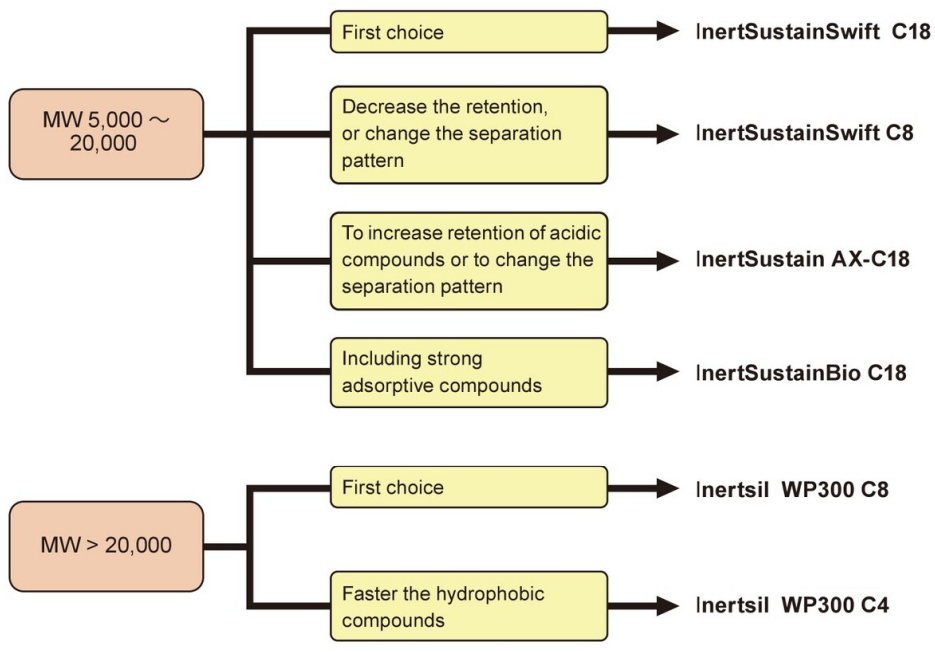
For Highly Polar Compounds
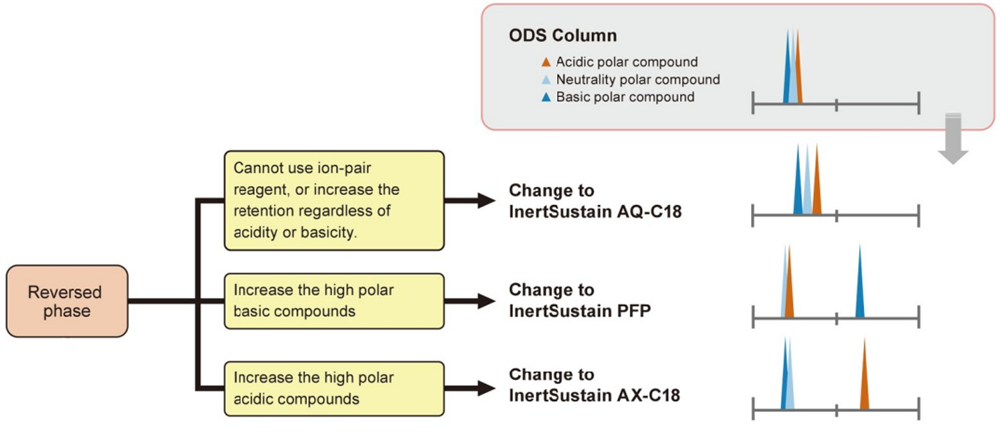
Reversed Phase Columns Resources:
- Download GL Sciences 2022 Reversed Phase Columns Catalog — Download & Discover GL Sciences' Reversed Phase Columns
- HPLC Reversed Phase Columns Specifications — Summary of GL Sciences HPLC Column Specifications. Learn More
- HPLC Reversed Phase Column Selection Overview — Separation mode selection for analyte polarity & HPLC column selection for analyte properties. Learn More
- HPLC Column Selection By USP — Recommended GL Sciences HPLC Columns based on USP Code. Learn More
- HPLC Column End-fittings — Summary of GL Sciences' end-fitting style & recommended operating pressure. Learn More
- How to Select a Guard Column — Download guide to select the right guard column. Learn More
- Choosing Preparative Column — Download Guide to select the right preparative column. Learn More


 Español (Taducido por Google)
Español (Taducido por Google) 







